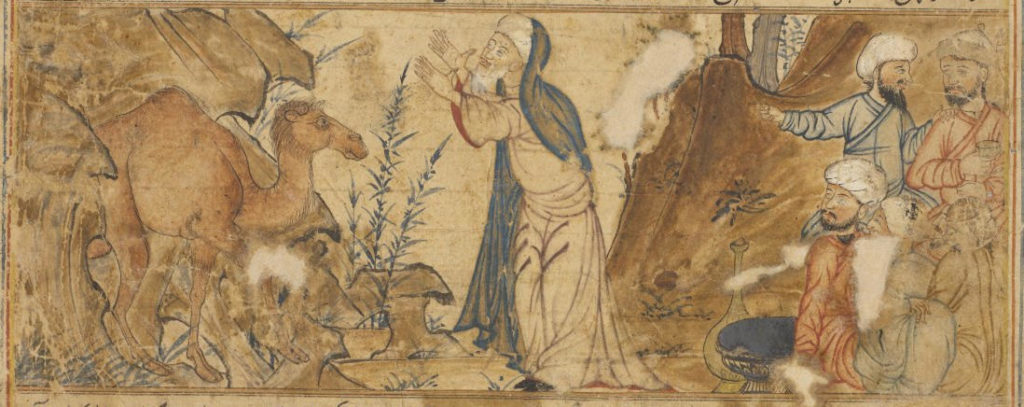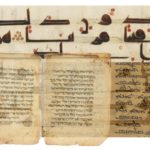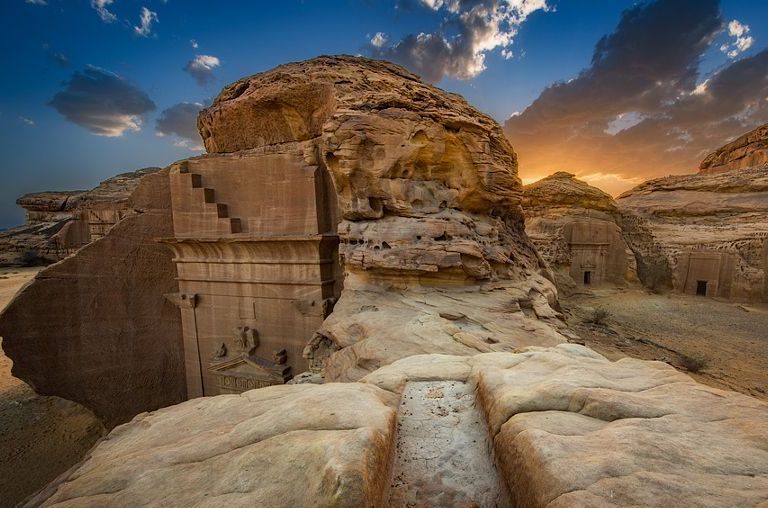
The beginning of the second millennium saw an unprecedented revolution in the study of the Qur’ān and Islam. Right from the outset we can see a huge gap between the text of the Qur’ān and the religion of Islam. Differences of opinion between traditionalists and critical scholars were already evident long before the discovery and decipherment of thousands of Arabic stone inscriptions found in Western Asia and Arabia.
BY JADOU JIBRIL
TODAY THE TRADITIONAL current is losing ground as new scholars use research methods similar to those used in biblical criticism in the analysis of the Qur’ānic text.
In the second half of the twentieth century, scholarly works began to challenge the consensus concerning the geocultural context of the emergence and formation of Islam. Linguistics and archaeological analyses have raised questions about where Islam originated and about the existence of Makka in early Islam. Researchers such as John Wansbrough, Christoph Luxenberg, Günther Lüling, Patricia Crone and Michael Cook[1] and others have come to the conclusion that an early version of the Qur’ān was written as a book by a Christian community of Syrian / Aramaic origin that was opposed to the Christian Orthodoxy of the Councils of Nicaea (325 AD) and Constantinople (553 AD).
What is more, this opinion went on to claim that the text of the Qur’ān differs markedly from the traditions of Islam that emerged a little over two centuries later, and highlighted the considerable geographical distance that separates the Hijaz and the central Arabian Peninsula from northeastern Persia, the original home of the Islamic kalām scholars and the authorities that the Islamic narrative relies on to this day.
Linguistics and archaeological analyses have raised questions about where Islam originated
Traditions of this narrative were collected in the Hadith and the Sīra (biographical works on Muḥammad). But in order to study the text of the Qur’ān from a historical perspective, some Western scholars argued that such traditions must be set aside in favour of focusing on interpreting the text in the light of historico-critical methods. Such a task, however, has its difficulties because it is difficult to shake off the influence of these traditional accounts.
Similarly, the question of the writing down of the Qur’ān and its relationship to tradition, as well as to the sages of the Talmud, was also addressed. At first, writing down the Qur’ān was opposed:
Woe be to those who write the Scripture with their hands and then say, “This is from Allah,” that they may purchase a small gain therewith. [2]
Islamic tradition claims that the Qur’ān and hadith were committed orally to memory from the time of Muḥammad until the tenth century thanks to professional ‘memorisers’ (al-ḥafaẓa) who transmitted the official text to each other without writing it down. With the expansion of the Muslim conquests rulers began to fear that the memorisers would perish in the battles and wars, and so hastened to have the texts written down.
Rabbinic traditionists similarly assert that skilled ‘memorisers’ succeeded one another from generation to generation, handing down the Halacha discussion until the time that the Talmud was written down around the tenth century. This assumption was made to justify the fact that Talmud texts remained oral for generations and were never written down.
Makka does not appear in the Qur’ān and Muḥammad is mentioned only four times in the text, likely as an adjective rather than a proper noun
It is surprising that the Qur’ān does not provide appropriate details for Muḥammad’s life. It gives no information about his parents, the exact place or date of birth, his family, his associates or his fellow travellers. The text attributes to him no miracles, healings or any raising of the dead. It does not feature any eloquent sermons or homilies on morality and wisdom as we find with Jesus in the Gospels or with Moses in the Torah. In fact, the personality of Muhammad is completely absent from the Qur’ān as a actual character. In contrast, the Qur’ān focuses primarily on the life of another figure: Jesus son of Mary. The central figures in the Qur’ān thus appear to be Mary and Jesus, along with Abraham and Moses – but not Muḥammad. Unlike the Gospels, the Qur’ān presents Jesus in a very positive way. What are we to conclude from this?
The text of the Qur’ān makes mention of something like 32 names of people, mostly biblical figures – all of them defined as ‘prophets’ without distinguishing between them. On the other hand, actual biblical prophets are nowhere mentioned, and this is probably no coincidence. Among these names there are only six that cannot be clearly identified in the Bible or the New Testament. The remaining 26 names come mostly from the Pentateuch. Thus, the two main protagonists mentioned in the Qur’ān are Jesus / ‘Īsā – referred to about 130 times, and Moses – also referred to 130 times. Then Abraham is mentioned 69 times and Noah 43 times (a whole sūra is named after Noah).
The central figures in the Qur’ān thus appear to be Mary and Jesus, along with Abraham and Moses – but not Muḥammad
The other characters are Adam (25 times), Lot (25 times), Aaron (20 times), Isaac (17 times), Solomon (17 times), David (16 times), Jacob (16 times), Ishmael (12 times), Jonah[3] (4 times), Job (4 times) and Elijah (twice). Elisha and Saul[4] are mentioned once each. Joseph is mentioned in the Qur’ān only as the name of a sūra (Yūsuf). Other figures cited include John the Baptist and his father Zechariah, Shu‘ayb (Jethro)[5], Idris (Enoch), Hūd (Eber?),[6]Dhū ’l-Kifl (Ezekiel?),[7] Luqmān,[8] Ṣāliḥ,[9] Al-Khadir[10] and Dhū ’l -Qarnayn (Alexander the Great).[11] It is unclear why Jesus is called ‘Īsā in the Qur’ān.[12] Mary, the mother of Jesus, is mentioned as ‘Aaron’s sister’[13] and is mentioned by name 11 times and 34 times as the mother of Jesus. In the New Testament the name is mentioned only 24 times. Contrary to what one might expect, Makka does not appear in the Qur’ān. Muḥammad is mentioned but four times in the text, likely as an adjective rather than a proper noun. In fact, the character of Muhammad is rarely referred to in the Qur’ān.[14]

Suggested Reading
In the absence of historical references to the writing down of the Qur’ān, researchers have turned to studying its geographical context. Tradition avers that the emergence of Islam took place in the Hijaz and the region around Makka, in the centre of the Arabian peninsula, far removed from the trade routes that cross the desert from Yemen to Damascus. This is a region that lay beyond the political control and cultural influences of the Egyptian, Assyrian, Babylonian, Persian, Greek and Roman empires. Its inhabitants left no physical traces but surprisingly, the descriptions of landscapes, climate and the environment in the Qur’ān do not correspond to life in an arid desert where the chances of survival are limited.
For unlike the reality of the Hijaz desert, the inhabitants in the Qur’ānic verses live in landscapes rich in water and streams, where wheat fields were bordered by palm trees, olive trees, vines, fig and pomegranate trees. It also mentions ships sailing in rough seas, it speaks of fishermen and their catch – things not part of the nature of the desert. The narrator al-Bukhārī described a prisoner marvelling at grapes growing out of season near Makka, and the Qur’ān rarely mentions or describes a desert landscape or scorching sand dunes. These geographical differences suggest that it is likely that the early nucleus of the Qur’ān emerged somewhere elsewhere than in the arid Arabian peninsula.
[1] Works by these authors can be found in the Almuslih Library.
[2] Qur’ān II (Al-Baqara), 79.
[3] The Qur’ānic form of the name (Yūnus) is interesting in that it seems to have been taken from the form it took in the Septuagint Greek translation: Ιωνάς Iōnas (with the addition of the Greek masculine nominative ending) rather than the Hebrew יוֹנָה Yōnāh. (Ed.)
[4] The translation of the Arabic طالوت Ṭālūt in the Qur’ān as ‘Saul’ has long been controversial since the identification with the first king of a united Israel appears to be confused with the story of Gideon. The Qur’ānic passage referring to Allah testing the faithful by how they drank water from a river: Whoever then drinks from it, he is not of me, and whoever does not taste of it, he is surely of me, except he who takes with his hand as much of it as fills the hand [Qur’ān II (al-Baqara), 249] is derived from the text in the Torah: So Gideon took the men down to the water. There the LORD told him, Separate those who lap the water with their tongues as a dog laps from those who kneel down to drink … With the three hundred men that lapped I will save you [Judges 7: 4-7]. (Ed.)
[5] The association of Shu‘ayb with Moses’ father-in-law Jethro was made by the fact that Jethro was a priest of Midian and Shu‘ayb was sent by God to an Arabian territory known as Madyan. Scholars dispute this association, arguing that his status among Muslims as great-grandson of Abraham conflicts with the identification with Jethro who lived at the time of Moses, centuries after Abraham. (Ed.)
[6] Hūd is held to have been a prophet and messenger of the ‘Ād tribe of ancient Arabia, and is sometimes identified with Eber (עֵבֶר), an ancestor of the Ishmaelites and Israelites, mentioned in the Old Testament Book of Genesis (10-11) and Books of Chronicles (1 Chronicles 1). (Ed.)
[7] Dhū ’l-Kifl has been identified by Muslims with various biblical prophets, most commonly Ezekiel. (Ed.)
[8] The identification of Luqmān is split between an ancient Arabian sage, a member of the tribe of ‘Ād and a figure whose origin is in Nubia, Sudan or Ethiopia. (Ed.)
[9] Ṣāliḥ is held to have prophesied to the Arabian tribe of Thamūd.
[10] Al-Khadir is not mentioned by name in the Qur’ān but Muslim hadith narrators (al-Bukhārī and al-Tirmidhī) report Al-Khadir as belonging to one of the People of the Cave and referred to as one of Our slaves, unto whom We had given mercy from Us, and had taught him knowledge from Our presence. [Qur’ān XVIII (al-Kahf), 65]. (Ed.)
[11] For the association of Dhū ’l -Qarnayn with Alexander the Great see, in the Almuslih Library: The Alexander Legend in the Qur’ān 18:83-102 in The Qur’ān in its Historical Context pp.175-203 and Tommaso Tesei, The Prophecy of Ḏū-l-Qarnayn (Q 18 :83-102) and the Origins of the Qur’ānic Corpus. (Ed.)
[12] The association has long puzzled scholars. Theories range from an Arabisation of Esau, to a metathesis of the Aramaic/Syriac form of the name Yēshū‘ or an adoption of the Mandaic term for Jesus: ʿ-š-u. Jews and Christians recognize in the Greek form of the name Ιησους (Jēsūs) – or in the oblique case Ιησου (Jēsū) – the Hebrew name יהושוע (Y’hōshū‘) in its later Hebrew and Aramaic equivalent ישוע(Yēshū‘). The Hebrew name parses grammatically and has a meaning: ‘God is Salvation.’ There is no recognised grammatical parsing for the Arabic name. Professor in Arabic Studies at Ohio State University Ahmad al-Jallad has an interesting theory for the origin of the form ‘Īsā, based on the discovery of a 3rd-4th c. AD Safaitic inscription: h ’sy nṣr-h m-kfr-k (‘O ‘sy help him against those who deny you’) where ’sy is a deity or divine title, possibly denoting ‘redeemer’. His argument is that when Christian preachers came to the area, the concept of Jesus as Messiah and redeemer was mapped onto the existing ‘sy. Later on, ‘sy also became a personal name. (Ed.)
[13] This Qur’ānic identification historically caused much controversy, since Aaron was the brother of Moses who lived long before the birth of Jesus. A hadith related of Mughīra ibn Shu‘ba suggests that Muḥammad was confronted by this error and explained himself thus: ‘When I came to Najran, they (the Christians of Najran) asked me: You read “Sister of Harun”, (i.e. Mary), in the Qur’an, whereas Moses was born well before Jesus. When I came back to Allah’s Messenger I asked him about that, and he said: “The (people of the old age) used to give names (to their persons) after the names of Apostle and pious persons who had gone before them.”” (https://sunnah.com/muslim:2135). One possibility for this confusion is that Muḥammad made this association based on contemporary Syriac poetic tropes, whereby Church fathers typologised the revered figure of Mary by symbolism, allegory and allusions to the name in biblical texts, such as this parallelism by Aphrahat (ob. 345 AD): “Mary stood on the shore of the river as Moses floated on the water; and Mary bore Jesus, after the Angel Gabriel announced to her”. A Lection of Jeremiah includes the phrase ‘the priest Aaron, the brother of Mary’ in the same paragraph as a celebration of how: ‘today the Virgin is being guided from Bethlehem to Zion, and today from earth to heaven’ as part of a liturgy that connects the two, and Guillaume Dye proposes that the Qur’ānic text ‘is deeply and directly related to specifically Hagiopolite Marian traditions’. See, in the Almuslih Library, G. Dye: The Qur’ān and its Hypertextuality in Light of Redaction Criticism. pp.13-15. (Ed.)
[14] For a discussion on this problem of the scant details of the life of Muḥammad, see Almuslih article: The Hidden Origins of early Islam – 2 . (Ed.)
Main image: The Prophet Ṣāliḥ produces a camel from out of a rock. Miniature from the Jāmiʿ al-Tavarīkh of Rashid al-Din, c.1307.

